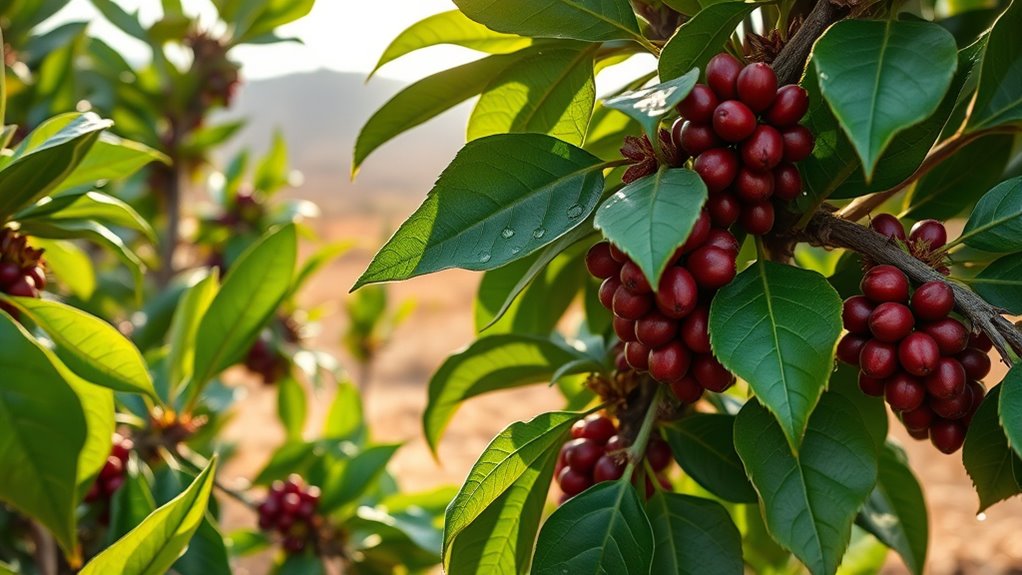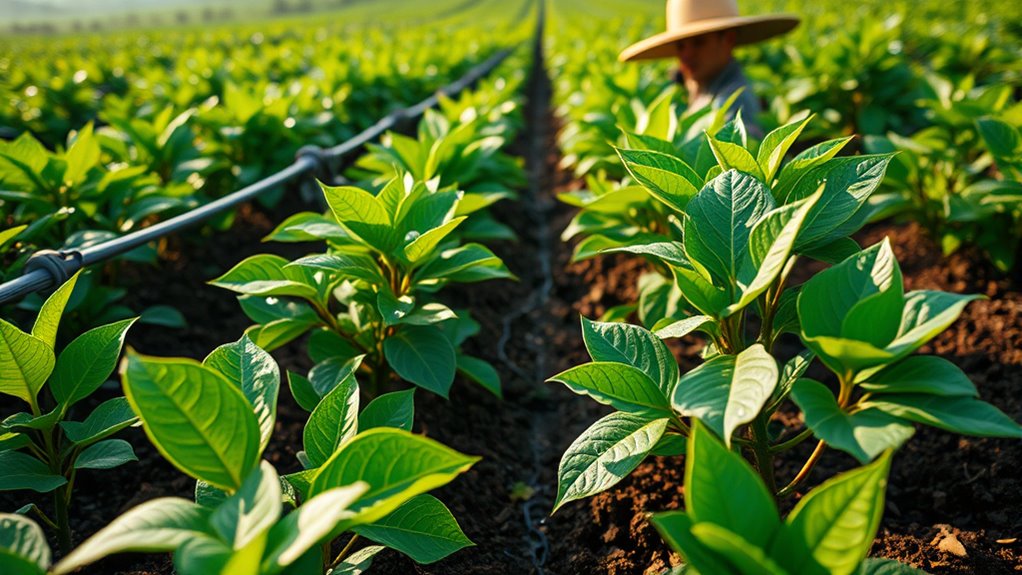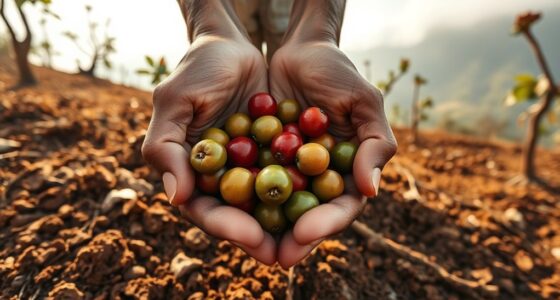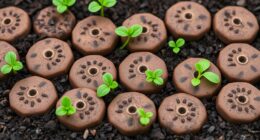Advances in agronomy are helping you make coffee plants more drought-resistant through breeding resilient varieties, improving soil and water management, and adopting precision irrigation technologies. You can select or develop strains with deep roots and stress tolerance, use cover crops and agroforestry to boost soil health, and implement drip systems with moisture sensors. These innovative practices not only conserve water but also support sustainable cultivation, so if you’re curious, you’ll discover even more ways to enhance resilience.
Key Takeaways
- Breeding programs incorporate wild relatives and genetic diversity to develop drought-tolerant coffee cultivars with maintained quality.
- Soil management practices like mulching, organic amendments, and cover cropping enhance water retention and soil health.
- Precision irrigation systems and soil moisture sensors optimize water use and reduce waste during drought conditions.
- Agroforestry and native vegetation buffers improve moisture conservation and ecosystem resilience.
- Policy support, farmer education, and public-private collaborations accelerate adoption of drought-resistant agronomic practices.
Breeding Drought-Tolerant Coffee Varieties

Breeding drought-tolerant coffee varieties has become essential as climate change intensifies water scarcity challenges. You can enhance coffee plant resilience by selecting and developing varieties that withstand dry conditions. Drought adaptation strategies involve identifying traits like deep root systems, efficient water use, and stress tolerance to improve survival rates during prolonged droughts. Breeders focus on crossing existing cultivars with wild relatives that naturally exhibit drought tolerance, aiming to produce resilient plants without sacrificing quality. By integrating these traits, you enable coffee plants to thrive in fluctuating climates, ensuring consistent yields and quality. Incorporating genetic diversity into breeding programs further enhances the chances of developing robust, drought-resistant varieties. This proactive approach reduces reliance on water-intensive practices and builds a more sustainable coffee industry, helping growers adapt to future climate uncertainties.
Innovative Soil and Water Management Practices

You can improve water retention in your soil by applying mulches and organic amendments, helping your coffee plants stay hydrated during dry spells. Precision irrigation systems, like drip or micro-sprinklers, deliver water efficiently where and when it’s needed most. Additionally, enhancing soil health through cover cropping and minimal tillage boosts its ability to retain moisture and supports overall plant resilience. Incorporating beneficial ingredients like hyaluronic acid into soil amendments can further improve moisture retention and plant health.
Enhanced Water Retention Techniques
To improve water retention in drought-prone coffee-growing regions, innovative soil and water management practices are essential. You can boost water conservation by enhancing soil structure, which promotes healthy root development and better water uptake. Mulching helps retain moisture and reduces evaporation, supporting roots during dry spells. Additionally, canopy management techniques, such as pruning, reduce transpiration and shade the soil, conserving water. Implementing organic matter amendments improves soil water-holding capacity. Here’s a quick overview:
| Technique | Benefits |
|---|---|
| Mulching | Moisture retention, weed suppression |
| Organic matter addition | Improved water-holding capacity |
| Canopy management | Reduced transpiration, shade for soil |
These practices work together to maximize water retention, ensuring coffee plants remain resilient during droughts. Soil health practices play a crucial role in sustaining water availability and supporting plant growth in challenging climates.
Precision Irrigation Strategies
Precision irrigation strategies have emerged as a game-changer in managing water efficiently for drought-resistant coffee cultivation. By targeting specific areas, you can optimize water use and improve plant health. For example, you might:
- Use drip irrigation systems to deliver water directly to the roots, minimizing waste.
- Monitor soil moisture levels with sensors to determine the exact watering needs.
- Adjust irrigation schedules based on weather forecasts and real-time data to prevent over- or under-watering.
- Incorporate nutrient-rich ingredients to support plant health and enhance drought resilience.
These practices ensure your coffee plants receive consistent moisture, reducing water stress and promoting healthy growth. Implementing precise control over water application helps conserve resources and boosts drought resilience, making your coffee cultivation more sustainable and productive.
Soil Health Improvement
How can innovative soil and water management practices enhance the health of drought-resistant coffee plants? By focusing on boosting your soil microbiome, you create a thriving environment for beneficial microbes that improve nutrient uptake and resilience. Incorporating organic amendments, such as compost or cover crops, enriches soil organic matter, enhances moisture retention, and fosters microbial diversity. These practices help maintain soil structure and prevent erosion, critical during drought conditions. A healthy soil microbiome supports plant roots in accessing water and nutrients more efficiently, reducing stress during dry spells. Regularly applying organic amendments and adopting soil-friendly management techniques strengthen the foundation for drought-resistant coffee plants, ensuring they stay productive and healthy even in challenging weather patterns. Additionally, understanding the importance of soil health improvement can lead to more sustainable farming practices that bolster plant drought tolerance over time.
Genetic Research and Marker-Assisted Selection

Advances in genetic research are transforming how we develop drought-resistant coffee varieties. You can now leverage genetic markers to identify traits linked to drought tolerance quickly. These markers allow you to select plants with desirable characteristics more efficiently. Additionally, DNA editing technologies enable precise modifications to enhance resilience without altering other traits. Here’s how this progress helps: 1. Using genetic markers, you can screen large populations rapidly to find drought-tolerant genes. 2. DNA editing allows you to directly modify specific genes responsible for drought resistance. 3. Marker-assisted selection accelerates breeding programs by combining traditional methods with molecular insights. Modern sound design techniques, such as digital sound synthesis, play a crucial role in creating realistic ambient sounds that can simulate dry or water-stressed environments for training or research purposes. Together, these strategies streamline developing coffee plants better equipped to withstand water stress, ensuring more sustainable production.
Use of Cover Crops and Agroforestry Systems

Using cover crops and agroforestry systems can substantially improve soil moisture retention, helping coffee plants withstand drought conditions. These practices also boost biodiversity, creating a healthier and more resilient ecosystem. By implementing these strategies, you can enhance both productivity and environmental sustainability. Incorporating encryption solutions into your farm management data can further safeguard sensitive information related to your operations.
Enhancing Soil Moisture Retention
Implementing cover crops and agroforestry systems can considerably improve soil moisture retention in coffee plantations, especially during drought periods. These practices help retain water through natural processes like water harvesting and soil amendments. To maximize benefits, consider:
- Selecting cover crops that increase organic matter, improving soil structure and water retention.
- Integrating trees that provide shade and reduce evaporation, enhancing moisture levels.
- Applying soil amendments such as compost or biochar to boost water-holding capacity and nutrient retention.
These strategies reduce runoff and evaporation, making soil more resilient to drought. Water harvesting techniques, like contour planting and mulching, further improve moisture retention. By adopting these methods, you optimize soil health, ensuring sustained coffee production during dry spells.
Promoting Biodiversity Benefits
Enhancing soil moisture retention through cover crops and agroforestry systems also offers significant biodiversity benefits. By planting diverse cover crops, you create pollinator habitats that attract bees, butterflies, and other beneficial insects crucial for coffee pollination. Agroforestry systems incorporate native plants, supporting native plant conservation and fostering a balanced ecosystem. These practices reduce the need for chemical inputs, promoting healthier soil and encouraging the presence of beneficial organisms. Additionally, maintaining native vegetation buffers protects wildlife and improves resilience against pests and diseases. You help create a more sustainable environment by integrating biodiversity into your coffee farm. This approach not only supports drought resistance but also enhances ecosystem stability, ensuring long-term productivity and ecological health. Implementing biodiversity practices can lead to more resilient and productive coffee cultivation.
Precision Agriculture Technologies for Water Efficiency

Advances in precision agriculture technologies are transforming how coffee growers manage water resources, especially in drought-prone regions. You can now optimize water use through innovative tools like drone mapping and IoT sensors. These technologies allow you to:
- Use drone mapping to identify areas with water stress, enabling targeted irrigation.
- Deploy IoT sensors in soil to monitor moisture levels in real-time, preventing over- or under-watering.
- Automate irrigation systems based on data insights, ensuring precise water delivery where it’s needed most.
- Incorporate sustainable tourism practices into farm management to reduce environmental impact and promote eco-friendly operations.
Collaborative Efforts and Policy Support for Climate-Resilient Coffee Farming

Building on the technological innovations in precision agriculture, collaborative efforts and supportive policies are essential to scaling up climate-resilient coffee farming. You benefit when farmers receive targeted education programs that improve understanding of drought-resistant practices, ensuring wider adoption. Effective collaboration between governments, research institutions, and coffee growers creates shared solutions and spreads knowledge quickly. Policy incentives, like subsidies or tax breaks, motivate farmers to implement sustainable practices and invest in new technologies. These policies also help reduce financial risks associated with *shift* periods. When farmers are empowered through education and supported by clear policies, the *changeover* toward climate-resilient coffee becomes more efficient and widespread. Additionally, fostering public-private partnerships can accelerate the development and dissemination of drought-resistant coffee varieties. Together, these efforts foster a resilient coffee industry capable of withstanding climate challenges.
Frequently Asked Questions
How Do Drought-Resistant Coffee Plants Impact Overall Flavor and Quality?
You might wonder how drought-resistant coffee plants affect flavor and quality. These plants help preserve flavor by reducing stress during dry periods, ensuring beans develop more consistently. As a result, you get better quality and more reliable flavor profiles. Drought-resistant varieties also promote quality consistency, so you can enjoy a richer, more uniform coffee experience, even in changing climate conditions.
What Are the Economic Implications for Farmers Adopting New Drought-Resistant Varieties?
Did you know that farmers adopting drought-resistant coffee can see a 20% reduction in crop loss? This shift can boost your market access and diversify your crops, making your farm more resilient. While initial costs may be higher, long-term savings and improved stability can increase your income. Embracing these varieties helps you adapt to climate change, ensuring sustainable profits and expanding your opportunities in the coffee market.
How Long Does It Take to Develop and Commercialize Drought-Tolerant Coffee Strains?
Developing drought-tolerant coffee strains typically takes 8 to 12 years, considering breeding timelines and regulatory hurdles. You’ll see a lengthy process involving initial research, multiple breeding cycles, extensive testing, and maneuvering approval processes. While it’s a significant investment of time, these efforts are vital for ensuring the new varieties are effective and safe. Patience is key, but the resulting drought-resistant coffee plants can help secure future yields and sustainability.
Are There Environmental Risks Associated With Genetically Modified Drought-Resistant Coffee?
Think of genetic modification as a double-edged sword—while it offers solutions like drought resistance, you must consider environmental safety. You might worry about unintended impacts, but proper genetic containment strategies help reduce risks. Current research shows that with responsible practices, the environmental risks are manageable. Still, ongoing monitoring is essential to ensure the coffee plants don’t disrupt ecosystems or transfer genes to wild relatives.
How Can Smallholder Farmers Access and Implement These Agronomy Advancements?
You can access these agronomy advancements through seed distribution programs supported by local governments or NGOs. They often provide drought-resistant coffee seeds directly to smallholder farmers. Additionally, participating in training programs helps you learn how to properly plant and care for these new varieties. Stay engaged with community groups and extension services to stay informed about upcoming initiatives, ensuring you implement these innovations effectively and boost your coffee farm’s resilience.
Conclusion
By embracing innovative ideas and inspiring initiatives, you can help make coffee cultivation more resilient and reliable. Through thoughtful techniques like testing, training, and technological tools, you’re empowering farmers to face droughts with confidence. Your commitment to cutting-edge research and collaborative efforts keeps coffee thriving despite climate challenges. Together, you can cultivate a future where coffee plants flourish freely, forging a fearless, fruitful frontier for coffee lovers and farmers alike.









